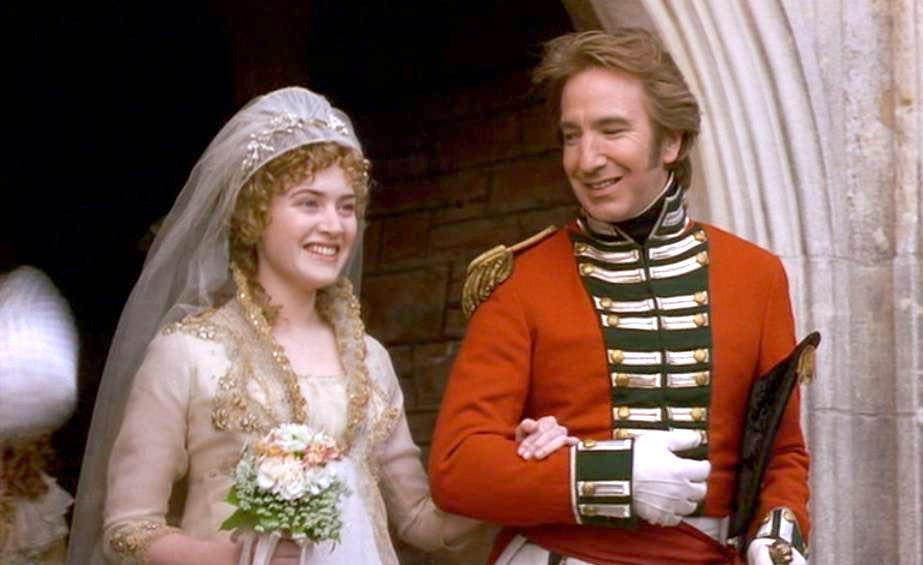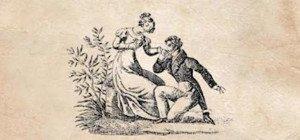
Weddings During the Regency Era
The bride was elegantly dressed; the two bridesmaids were duly inferior; her father gave her away; her mother stood with salts in her hand, expecting to be agitated; her aunt tried to cry; and the service was impressively read by Dr Grant.
Mansfield Park
 Say the word "wedding" and most of us think about a bride dressed all in white, half a dozen brides maids (or more), a big bash with loads of guests and a huge cake. But what kind of weddings where common during the Regency era and Jane Austen's lifetime? Did the bride wear white?
Say the word "wedding" and most of us think about a bride dressed all in white, half a dozen brides maids (or more), a big bash with loads of guests and a huge cake. But what kind of weddings where common during the Regency era and Jane Austen's lifetime? Did the bride wear white?
A Family Affair
Royal weddings tend to be big and there was no exception when Princess Charlotte married Prince Leopold in 1816.As we have been gratified with a sight of the wedding dresses of this amiable and illustrious female, a particular yet concise account of them cannot but be acceptable to our fair readers. The Royal Bride, happy in obtaining him whom her heart had selected, and whom consenting friends approved, wore on her countenance that tranquil and chastened joy which a female so situated could not fail to experience. Her fine fair hair, elegantly yet simply arranged, owed more to its natural beautiful wave than to the art of the friseur; it was crowned with a most superb wreath of brilliants, forming rosebuds with their leaves. Her dress was silver lama [lamé] on net, over a silver tissue slip, embroidered at the bottom with silver lama in shells and flowers. Body and sleeves to correspond, elegantly trimmed with point Brussels lace. The manteau was of silver tissue lined with white satin, with a border of embroidery to answer that on the dress, and fastened in front with a splendid diamond ornament. Such was the bridal dress ... The jewellery of the royal bride is most superb; beside the wreath, are a diamond cestus, ear- rings, and an armlet of great value, with a superb set of pearls. The court dresses worn by the royal family and nobility on this occasion were particularly splendid; we are sorry our limits will not allow us to enter into particulars, but we cannot forbear noticing the singular taste and elegance, displayed in the superb lama dress, so beautifully wrought with silver lilies, of the Marchioness of Cholmondeley; we have never before witnessed so charming a combination of classical taste, splendour, and touching simplicity.
La Belle Assemblee (May 1816)
However, most weddings in Jane Austen's time were private, family affairs. Even fashionable weddings at the church of choice of the day were but sparingly attended, usually only by close relatives or, if in the village church, by the local inhabitants. The bride did have a few attendants, mainly unmarried younger sisters or cousins. The groom commonly had his best man and the witnesses, of course. Usually the bride's parents attended,as well. What about the lavish party? Well, there wasn't always one! Consider Charlotte Lucas' wedding day in Pride and Prejudice,"The wedding took place; the bride and bridegroom set off for Kent from the church door."  Most weddings were performed in church after the reading of banns. Unless the couple had a license the ceremony had to be performed in church before lunch time (hence the popularity of the Wedding Breakfast!). The very rich, like the De Bourghs and the Darcys, would sometimes marry by special license in the family drawing room but it was very costly. Ever socially conscious, Mrs. Bennet exclaims over Mr. Darcy's fortune, "Ten thousand a year, and very likely more! 'Tis as good as a Lord! And a special licence! You must and shall be married by a special licence!" According to Henry Churchyard of the Jane Austen Information Page, "All of Jane Austen's couples would have been married according to the ceremony taken from the Church of England Book of Common Prayer; Emma Woodhouse refers to the part in which "N. takes M." for her wedded husband "for better, for worse". This "Form of Solemnization of Matrimony" has remained almost entirely unchanged from 1662 to the present."
Most weddings were performed in church after the reading of banns. Unless the couple had a license the ceremony had to be performed in church before lunch time (hence the popularity of the Wedding Breakfast!). The very rich, like the De Bourghs and the Darcys, would sometimes marry by special license in the family drawing room but it was very costly. Ever socially conscious, Mrs. Bennet exclaims over Mr. Darcy's fortune, "Ten thousand a year, and very likely more! 'Tis as good as a Lord! And a special licence! You must and shall be married by a special licence!" According to Henry Churchyard of the Jane Austen Information Page, "All of Jane Austen's couples would have been married according to the ceremony taken from the Church of England Book of Common Prayer; Emma Woodhouse refers to the part in which "N. takes M." for her wedded husband "for better, for worse". This "Form of Solemnization of Matrimony" has remained almost entirely unchanged from 1662 to the present."
 Bridal Fashions
Bridal Fashions
How common the white wedding dress was during the Regency era is hard to say, but we have some reasons to suspect that it was more prevalent than many may think. Although no bridal fashion prints survive from before 1813, paintings of wedding scenes, such as Highmore's 1743 illustration for Samuel Richardson's Pamela, do depict brides in white. Veils seems to have become popular somewhat later in the century so most brides either wore flowers in their hair, a cap or sometimes a hat. When Jane Austen's niece Anna married Benjamin Lefroy in 1814, she wore "a dress of fine white muslin, and over it a soft silk shawl, white shot with primrose, with embossed white-satin flowers, and very handsome fringe, and on her head a small cap to match, trimmed with lace."* Although bouquets and flowers with personal meanings came into vogue during the Victorian era, flowers and herbs have been used in weddings since the beginning of time as a way of showing love and well wishes to everyone. The first recorded use of wedding flowers dates back to the ancient Greeks. Flowers and plants were used to make a crown for the bride to wear and were considered a gift of nature. Bridesmaids would make the floral decorations including garlands, bridal bouquet and boutonniere.
Wedding Announcements
The newspaper announcement was, perhaps, the most socially important part of the wedding. Jane Austen, herself, once wrote, "The latter writes me word that Miss Blackford is married, but I have never seen it in the papers, and one may as well be single if the wedding is not to be in print.""I suppose you have heard of it; indeed, you must have seen it in the papers. It was in the Times and the Courier, I know; though it was not put in as it ought to be. It was only said, 'Lately, George Wickham Esq., to Miss Lydia Bennet,' without there being a syllable said of her father, or the place where she lived, or anything. It was my brother Gardiner's drawing up too, and I wonder how he came to make such an awkward business of it. Did you see it?"
Yvonne Forsling is a culitvator of exoctic Hibiscus and Regency Enthusiast. Visit her site, Yvonne'Space for a look into her passions and talents. Further discussion of Regency colour, as well as many other period plates can be found in the Regency Section of her website.
*Reminiscences by Caroline Austen + From Love to Know: Weddings
Enjoyed this article? If you don't want to miss a beat when it comes to Jane Austen, make sure you are signed up to the Jane Austen newsletter for exclusive updates and discounts from our Online Gift Shop.



2 comments
https://suck-my-dick.xyz – free porn
maer#$%fhyt
LauraDug
I’m writing a novella set in the Regency period and needed accurate information about wedding
customs, clothing, etc. These articles and pictures were very helpful.
Helena Korin
Leave a comment
This site is protected by reCAPTCHA and the Google Privacy Policy and Terms of Service apply.